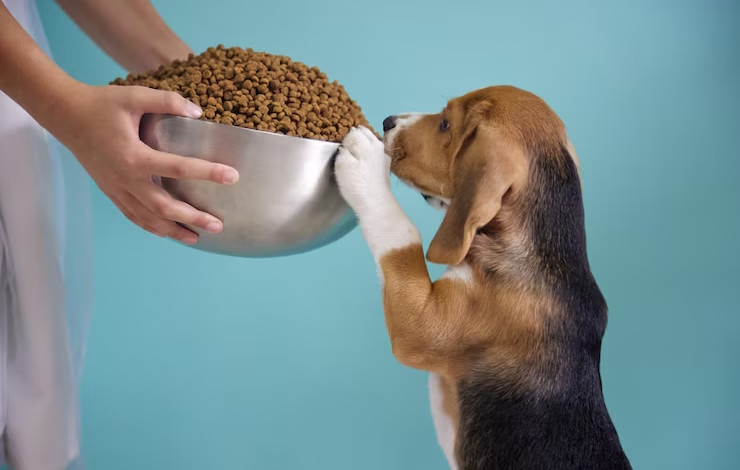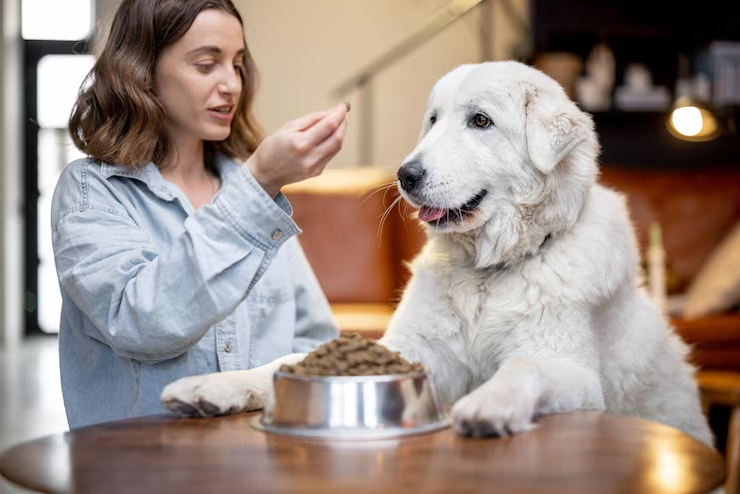Why Grain-Free Dog Food is a Great Choice for Your Pup’s Health

Grain-Free Dog Food has become increasingly popular among pet owners who want to give their furry friends a healthier diet. If you are concerned about your dog’s allergies, digestive issues, or overall health, switching to grain-free dog food can be a great option. Unlike traditional dog food, which often contains grains like wheat, corn, and soy, grain-free options focus on protein-rich ingredients that are easier for your dog to digest.
Many dog owners are finding that grain-free dog food helps reduce skin irritations, stomach upsets, and weight gain. By eliminating grains, your dog can enjoy a diet that supports better digestion and provides essential nutrients from high-quality meat and vegetables. In this blog post, we will dive into the benefits of grain-free dog food and why it could be the perfect choice for your pet.
What is Grain-Free Dog Food?
Grain-free dog food is a type of pet food that doesn’t contain grains like wheat, corn, or soy. Instead, it uses other ingredients like meat, vegetables, and fruits. Many people choose this type of food because they believe it helps their dogs with health issues like allergies or tummy troubles. It focuses on giving dogs more protein from high-quality meats instead of grains.
If your dog is sensitive to certain foods, you might notice that switching to grain-free dog food can help. Some pets have difficulty digesting grains, and this food can be easier on their stomachs. By cutting out grains, dogs can get all their nutrients from other sources like chicken, beef, or sweet potatoes.
Top Benefits of Switching to Grain-Free Dog Food
Switching to grain-free dog food can have several positive effects on your dog’s health. One of the biggest benefits is better digestion. Since dogs can have trouble digesting grains, they may experience fewer stomach problems when eating food without them. This can lead to less bloating, diarrhea, or vomiting.
Another advantage is that grain-free dog food is often richer in protein. This helps your dog maintain muscle and keeps them feeling energetic. It can also help with weight management, as some grain-free options contain fewer carbohydrates and more high-quality ingredients. If you want your dog to stay healthy and strong, this is a great choice.
How Grain-Free Dog Food Improves Your Dog’s Digestive Health
Grain-free dog food can improve your dog’s digestion by using easy-to-digest ingredients like meats and vegetables. Dogs have a digestive system designed to process proteins and fats, so a food that focuses on these ingredients may be better for them. By removing grains, which are harder for some dogs to process, you reduce the risk of upset stomachs or other digestive problems.
Benefits of better digestion:
- Less bloating and gas
- Fewer tummy aches
- More regular bowel movements
- Happier, more active dog
A healthy digestive system means your dog can absorb more nutrients from their food, which helps keep them healthy. Grain-free dog food provides a balanced diet that supports good digestion and overall wellness.
The Best Grain-Free Dog Food Options for Every Breed
Not all grain-free dog food is created equal. The best options depend on your dog’s breed, size, and specific needs. For example, smaller dogs might need grain-free food that is easier to chew, while larger breeds may require something more filling. Each dog has unique nutritional needs, so it’s important to choose a food that works best for them.
Top grain-free food brands for different breeds:
- For small dogs: Look for bite-sized kibble and high protein content.
- For large dogs: Choose options that support joint health and muscle maintenance.
- For puppies: Find food with extra vitamins and minerals for growth.
Choosing the right grain-free food can help your dog maintain a healthy weight, strong muscles, and a shiny coat. Make sure to read the labels and pick food with high-quality ingredients that support your dog’s overall health.
Grain-Free Dog Food vs. Regular Dog Food: Which is Better for Your Dog?

When deciding between grain-free dog food and regular dog food, it’s important to understand the differences. Regular dog food often contains grains like corn and wheat, which can be harder for some dogs to digest. On the other hand, grain-free dog food replaces these grains with ingredients like sweet potatoes, peas, and lentils.
Why grain-free might be better:
- Easier to digest
- Often richer in protein
- Reduces allergy symptoms
- Supports healthy weight
However, regular dog food can still be a good choice for dogs that don’t have any digestive issues or allergies. It’s always best to consult with your vet before making the switch, especially if your dog has special dietary needs.
Signs Your Dog Might Need Grain-Free Dog Food
If your dog shows signs of allergies or digestion problems, they may benefit from grain-free dog food. Symptoms like itchy skin, frequent ear infections, or an upset stomach can indicate a food sensitivity. If your dog has trouble digesting regular dog food, switching to a grain-free option can often help them feel better.
Common signs to watch for:
- Itchy skin or rashes
- Upset stomach or vomiting
- Diarrhea or constipation
- Lack of energy or weight gain
If you notice any of these signs, it’s a good idea to talk to your vet. They can help determine if grain-free dog food might improve your dog’s health.
How to Transition Your Dog to Grain-Free Dog Food: A Step-by-Step Guide
When switching your dog to grain-free dog food, it’s important to do it gradually. This helps your dog’s digestive system adjust to the new food without causing upset. Follow this simple guide to make the transition smooth and easy for your dog.
Steps for a successful transition:
- Mix the old and new food: Start by mixing a small amount of grain-free food with your dog’s regular food.
- Increase the amount gradually: Over the course of 5-7 days, slowly increase the amount of grain-free food while decreasing the old food.
- Watch for signs of discomfort: Keep an eye on your dog’s digestion during the switch. If you notice any problems, slow down the transition.
By making the change slowly, you help your dog adjust to their new diet and give their stomach time to adapt.
Understanding the Ingredients in Grain-Free Dog Food
Grain-free dog food is made with a variety of ingredients that are carefully selected to provide high-quality nutrition. Instead of grains, it includes ingredients like chicken, beef, sweet potatoes, and peas. These ingredients are easy for dogs to digest and provide all the nutrients they need for good health.
Common ingredients in grain-free dog food:
- Proteins: Chicken, turkey, beef, lamb
- Carbohydrates: Sweet potatoes, peas, lentils
- Vegetables and fruits: Carrots, blueberries, apples
When choosing grain-free food, make sure to look at the ingredient list and choose one that uses real meat and healthy vegetables as the main ingredients. Avoid foods with too many fillers or artificial additives.
Common Myths About Grain-Free Dog Food You Should Know

There are many myths about grain-free dog food, and it’s important to separate fact from fiction. Some people believe that grain-free food is only for dogs with allergies or digestive issues, but that’s not true. Even healthy dogs can benefit from grain-free food because it’s often higher in protein and lower in carbs.
Myths to watch out for:
- Myth 1: Grain-free dog food is only for dogs with allergies.
- Myth 2: Grain-free food is always better than regular food.
- Myth 3: Grain-free food is expensive and unnecessary.
In reality, grain-free dog food can be a great option for many dogs, but it’s important to choose the right food based on your dog’s specific needs. Always talk to your vet before making any major changes to your dog’s diet.
Conclusion
In conclusion, grain-free dog food can be a great option for many dogs, especially those with food sensitivities or digestive issues. By choosing food that is made without grains like wheat, corn, and soy, you may help your dog feel better and stay healthier. Grain-free options focus on proteins and vegetables, which are easier for dogs to digest and can provide them with the nutrients they need for strong muscles and a shiny coat.
If you’re thinking about switching to grain-free dog food, make sure to check with your vet first. They can help you decide if it’s the right choice for your dog based on their breed, age, and health. With the right food, your dog can live a long, happy, and healthy life!
FAQs
Q: What is grain-free dog food?
A: Grain-free dog food is food made without grains like wheat, corn, and soy. It uses other ingredients like meat and vegetables to provide your dog with nutrients.
Q: Is grain-free dog food good for all dogs?
A: Grain-free dog food is great for dogs with allergies or digestive issues, but it’s best to check with your vet before switching to see if it’s right for your dog.
Q: Does grain-free dog food help with dog allergies?
A: Yes, grain-free dog food can help reduce skin problems, ear infections, and other allergy symptoms in dogs who are sensitive to grains.
Q: How do I switch my dog to grain-free food?
A: Slowly mix the new grain-free food with their regular food for 5-7 days, gradually increasing the amount of grain-free food.
Q: Can puppies eat grain-free dog food?
A: Yes, puppies can eat grain-free food, but make sure to choose one that has the right nutrients for growing pups. Always consult your vet for the best choice.



